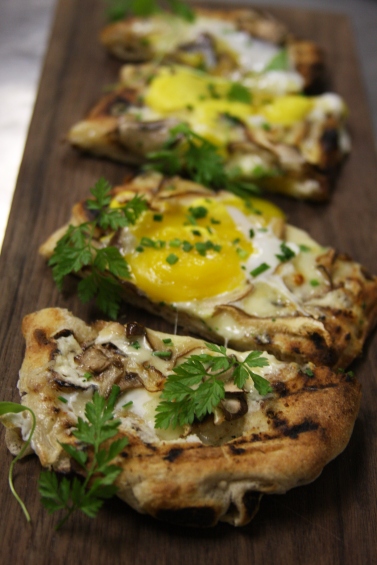
This blog post comes from Megan Parker, the new General Manager of The Bagby Group’s upcoming Cunningham’s Cafe & Bakery. On her own volition, she wanted to learn more about the artisan bread that will be offered this fall at the new Towson cafe. This was her experience with Bagby Head Baker John Aversa…
“Few things are as ordinary as a loaf of bread, yet the process by which it is made is extraordinary” – Michael Pollan, Cooked.
During my years as a restaurant manager, 10pm used to be the middle of my workday; a whirling medley of food, wine, servers, guests, plates, glasses, and silverware. Thus it felt strange – though also calming – to arrive at Fleet Street Kitchen at that hour to begin an all-night shift baking bread.
Baking bread for a living is not easy work; the long, odd hours – times when most of us are fast asleep – is just one of the hardships bakers endure. The heat is another. Difficult even today, for centuries bakers worked in their underwear, straining amid the torrid calidity of their bakeshops. (Don’t worry folks – everyone at Fleet Street Kitchen is fully clothed!)
Bakers have also been the targets of violence during times of political strife. During the French Revolution, accused of cheating their customers on weight, some were quite literally thrown into their ovens. Responding to the violence, some bakers began including an extra loaf in their orders to ensure their customers were happy and that they would live to bake another day! This has come to be known as the “baker’s dozen.”

Facing such hardships, the artisan baker is an increasingly rare breed. Truly it is a lot to balance: the technical knowledge to understand and execute complicated formulas, the patience to oblige and respect the organic processes that take place on their own schedule, the strength to deftly manipulate fifty pounds of slippery dough as well as the artistic ability to hand form the dough into countless different styles and score it perfectly to produce a beautiful and flavorful loaf. We eat first with our eyes, after all.
On the evening I arrived, I joined our Head Baker, John Aversa, and Michelle, his young assistant. Enthusiastic and eager, I expected to jump into things, but was immediately impressed by the meticulous care that went into every step of the baking process; artisan bread is laborious and never easy. We began by gathering supplies, ingredients were weighed and put in the cavernous mixer at specific intervals and then the heavy, cumbersome dough that resulted was placed into large containers to rise until the “first turn.” Different breads, I would discover have different rise times, depending on the amount and type of starters they use. The levain and pouliche we use in our breads are natural starters, which allow the breads to rise without the use of commercial yeasts. John has adapted his formulas throughout the years and while he relies on them to an extent, much of the dough making process was a matter of him “feeling” the other variables, such as temperature and timing. Ultimately, he would know when the dough was ready by knowing what to look for. Bakers sometimes judge dough by the window test – stretching the dough so that it’s thin enough to see through, without breaking. This is one way to see if enough gluten has developed to strengthen the dough.
While John is a baker with a reverence and deep respect for tradition, he also has his own methods and approach. This was made evident when we began our brioche, a notoriously difficult dough to work with due to the amount of butter that’s called for. Butter, while a common topping to bread, is rarely used in the dough – none of the other breads we made that night used any. Traditional French bakers have a very particular way of making brioche, keeping the butter very cold and adding it in very small amounts to the mix. While John keeps his butter chilled right up until he needs it, he deviates by beating the butter until it’s thoroughly whipped, and then adds it to the dough all at once. This break from convention would engage many a traditionalist but I’m here to tell you that the finished product rivals the brioche I can clearly remember savoring in Paris.

By 1:00 am, all the dough was mixed: pain complet, sesame semolina, baguette, ciabatta, Italian, focaccia, multi grain, and brioche. The times for turning each type of dough were determined and recorded in Michelle’s notebook. We moved to the next kitchen for our first lesson in forming. We started with the most difficult of all of the breads, the iconic baguette. “Palms on the table please,” John reminds us as we’re rolling out the delicate portions. My competitive nature was my downfall here, as I discovered you couldn’t actually beat dough into submission. It’s alive and unforgiving at this stage. I was disappointed in the fat ends of my baguettes in comparison with John’s beautifully tapered forms.
At this point, I realized just how many factors are crucial to crafting exquisite bread: the frequency and temperature at which you feed your starter (which will ultimately determine if it’s mild or strongly flavored bread) , the timing and number of turns, the preform, shaping, proofing, scoring, steaming, bake time and a myriad of factors that I can’t comprehend, all have a significant effect on the appearance and taste of the end product. I could truly appreciate what it meant to be an artisan baker and it could not be boiled down to an exact science. It was the sum of many skills and an artistry that is not learned in a few years of school or apprenticeship, but achieved through a lifetime of passion and commitment to the craft of bread making.

Back to forming…..we moved from baguettes to batards, which proved to be slightly easier for me to handle. At this point, I started talking to the dough and asking it to cooperate and forgive me because it was my first time. Next we did boules and finally brioche rolls, which were the simplest to shape, and I actually attempted rolling 1 in each hand. The brioche is always the most difficult to work with because of the amount of fat in it’s make up, but we were able to braid them and then make some brioche à tête just for fun. This gave me a small amount of confidence for my forming abilities and when they came out of their molds in the oven, I tasted victory.
Ultimately, at 6:30am, I gave in to my exhaustion, and left just before the last loaves were to come out of the ovens. John and Michelle were jovial and optimistic about the evening’s work and I thanked them for allowing me a window into their world. The most significant thing I gained from my all night baking experience was the ability to gauge a loaf of bread by looking at it – the height, the shape, the color and the cell structure of the crumb (interior) reveal much about what it will taste like and the amount of care that was taken in creating it.
The next time you eat at any of The Bagby Group’s restaurants (Bagby Pizza Company, Ten Ten American Bistro, Fleet Street Kitchen or, this fall in Towson, Cunningham’s and Cunningham’s Café & Bakery), take notice of the bread and you’ll taste what I mean. The flavor and soul of these breads are much more than just the sum of their parts.


























